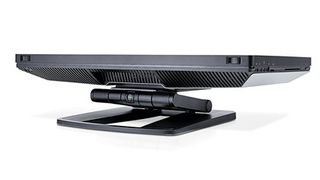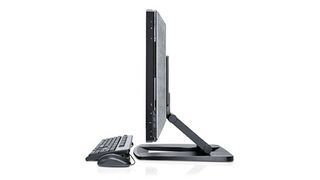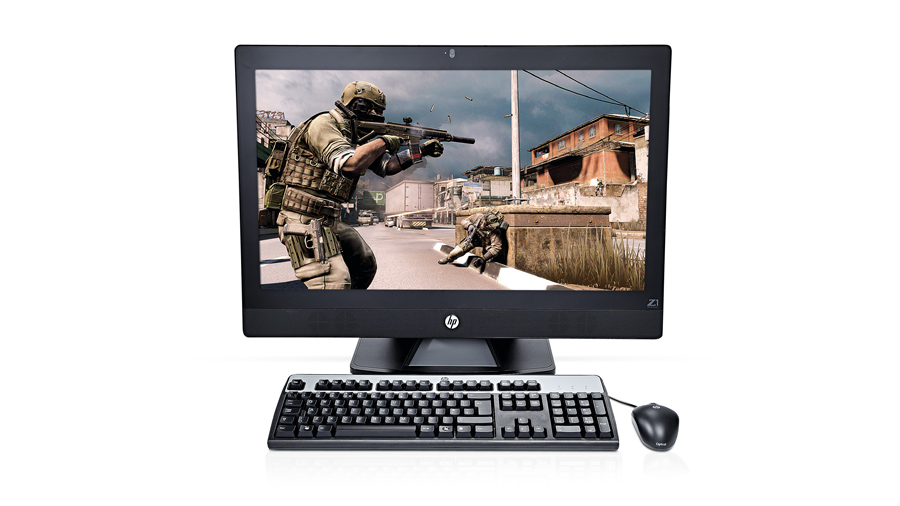TechRadar Verdict
Pros
- +
Excellent build quality
- +
Easily upgraded
- +
Quality IPS screen
Cons
- -
Lack of performance
- -
No SSD as standard
- -
Price
Why you can trust TechRadar
Time for a spot of word association. We say workstation, you think big, black monolith. Right? That certainly used to be the drill for powerful systems that were aimed at 'professional content creators', as the ghastly industry jargon goes.
Well, that is except for mobile workstations, which are typically little more than flashy laptops with bespoke graphics drivers. What to make, then, of HP's new Z1 all-in-one workstation?
The most obvious comparison is Apple's iMac, a machine ostensibly intended for lightweight multimedia duties in the home or as a stylish office desktop, but often found doing much heavier lifting than that. We'll come back to it in a moment.
Open and shut case

As a physical object, the Z1 is simply awesome. We've seen some fancy engineering in our time. But as far as desktop kit goes, the Z1 represents a new high.
The most delightful aspect is the way the whole thing tilts over on its hefty stand until the chassis is completely horizontal. Pop a couple of latches and marvel as the screen surface rises with oily, damped precision, laying the innards bare.
You're then presented with the second most impressive engineering exhibition - the manner in which the Z1's components have been integrated into the all-in-one enclosure. It's a beautiful bit of work, not only in terms of the visual layout but also access to components.
Believe it or not, it's easier to swap the memory or hard drive in the Z1 than it is a conventional tower PC - it's that slick. There's even plenty of scope for expansion with no fewer than three mini PCIe slots.
Then there's the graphics installation. The Z1 sports what looks for all the world like a conventional PCI Express board, cleverly clamped flat to the motherboard. It's hilariously easy to pop it out, at which point you discover that the board is much smaller than you thought and is actually based on Nvidia's MXM mobile form factor, surrounded by extended cooling apparatus.
The downside there, of course, is that while the graphics pop in and out with ease, buying replacement or upgrade boards isn't straightforward. You'll have to source them from HP, and that's never going to be cheap.
What else can we tell you about the physicals? Well, the 27-inch LCD panel is located below a glass cover, which adds to the slick aesthetic but also increases reflectivity. Perhaps it's an inevitability given how shonky a recessed screen would look.
But with a workstation, you might think form would follow function. Another downside to the heavy engineering is sheer mass. The Z1 weighs a metric ton.
But the only real disappointment in this area involves the crap-tastic keyboard and mouse. Our workstation came with the wired items rather than the optional wireless kit, and they're cheap, nasty and completely ill at ease with the quality of the machine proper. That's a shame.
But what of the detailed specification? This is where things get really interesting. On the CPU side we have an Intel Xeon E3-1280. That's a 3.5GHz quad-core model that slides into the LGA 1155 socket, and it presents a problem.
Pound for pound, Xeon chips are more expensive than their Core cousins. In most workstations, that's forgivable because they give you more options. You can, for instance, have more than one socket. You can also buy Xeon processors with extra cores. Again, it all costs, but if you want maximum performance in a single box, a Xeon processor is the way to go.
The problem for the Z1 is that it's a single-socket system, and an LGA 1155 item at that. That means you can't have more than one CPU, and you can't have more than four cores. Which begs the question why you would bother buying a Xeon.
At this point, someone from Intel will pipe up about validation and error correction on the memory side. But aside from a few exotically mission critical applications, our reply is a simple: meh.
Next up is graphics. Here again we're talking workstation class kit - in this case an Nvidia Quadro 1000M chip. Workstation graphics can be a very different beast from desktop graphics. Apart from the different driver package, some workstation chips have much stronger double-precision performance which certainly does matter to a wide range of widely used professional applications.
Unfortunately, the latter doesn't apply to the 1000M. It's basically a re-badged GeForce 540M with 96 shaders, so there's no ECC memory support or turbo-charged double precision performance. Shame.
If that's a bit disappointing, the hard drive is downright insulting. It's a 1TB magnetic Hitachi 7,200rpm model, and not at all what we were expecting - especially now that solid-state drive prices have fallen so dramatically.
Having said all that, one area where HP has got it just right is the choice of LCD panel. It has used one of LG's 27-inch IPS jobbies and it's as gorgeous as ever. Along with the 2,560 x 1,400 native resolution, you get impeccable viewing angles, uber nice colours and super contrast. The only niggles involve that glass cover and the slightly grainy anti-glare coating underneath. It was ever thus with IPS panels.
All of which just leaves the minor matter of performance. Predictably, the storage part of the equation basically blows. Magnetic platters are no match for memory chips when it comes to random access. You could argue that's an easy upgrade, and it is, but surely a machine of this class should come with an SSD as standard?
Underpowered

On the CPU side, it's standard Intel quad-core fare, which means very, very good but not actually anything special - again in the context of the Z1's monumental list price. The graphics performance is nothing special, either. In fact it's quite poor.
While we only tested games, we're confident the Z1 will be no powerhouse when it comes to hardware accelerated rendering. There's much more bang for your buck available elsewhere.
And that brings us back to ye olde iMac. Even a basic iMac now has a quad-core Intel chip. Okay, it's not clocked as high as the Z1, but you won't feel the difference. It's a similar situation on the graphics side, where the 27-inch iMac packs more powerful 3D kit even if its Radeon chips aren't terribly workstation-app friendly.
And yet the Z1 still appeals. It's much more configurable, user friendly and upgradeable than an iMac, and offers much broader workstation validation. Of course, there's also the Mac OS vs Windows thing, though you do have the option of dual booting on the Mac. But money no object, we wouldn't blame you if HP got the nod.
Technology and cars. Increasingly the twain shall meet. Which is handy, because Jeremy (Twitter) is addicted to both. Long-time tech journalist, former editor of iCar magazine and incumbent car guru for T3 magazine, Jeremy reckons in-car technology is about to go thermonuclear. No, not exploding cars. That would be silly. And dangerous. But rather an explosive period of unprecedented innovation. Enjoy the ride.
Most Popular


